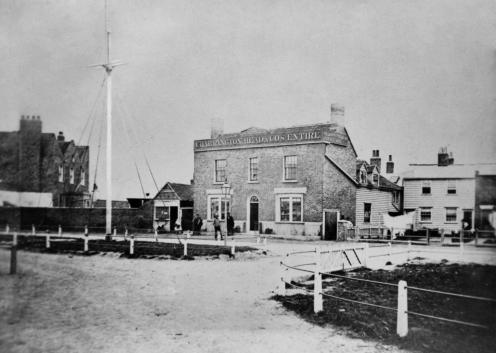The Britannia
All
that
is
known
about
the
early
history
of
the
Britannia
public
house
is
that
it
was
built
in
about
1793
as
a
residence.
According
to
Stephen
Pewsey
in
his
1993
publication,
"The
Book
of
Southend-on-Sea",
the
building
was
nearly
200
years
old
and
must
have
been
built
in,
or
shortly
after
1793.
This
date
coincides
with
both
the
opening
of
the
Royal
Hotel
(as
part
of
a
'New
Town'
of
Southend
on
land
granted
by
Daniel
Scratton
of
Little
Waltham)
and
the
completion
of
Abraham
Vandervord's
'Great
House'
(later
the
Minerva
Hotel)
on
land
granted
by
the
same.
Daniel
Scratton
was
the
Lord
of
the
Manors
of
Prittlewell
Priory
and
Milton
Hall
at
the
time.
The
Minerva
and
Britannia
buildings
stand
very
close
to
each
other
and
were originally on adjacent plots.
Daniel
Scratton
had
granted
the
land
for
the
building
of
the
Great
House
(Minerva)
when
sitting
in
the
manorial
court
on
16th
January
1792.
No
record
was
found
of
the
granting
of
land
or
building
of
the
Britannia.
The
land
could
have
been
granted
in
the
same
court
session
and
the
possibility
that
the
Britannia
was
originally
associated
with
the
Great
House cannot be discounted.
Both
the
Great
House
and
Britannia
can
be
seen
standing
close
to
each
other
in
early
depictions
of
the
town.
In
an
engraving
(dated
as
before
1830
by
the
absence
of
the
pier)
and
a
painting
of
"Royal
Terrace
from
the
Sea,
1807"
by
C.
C.
Coventry
(Beecroft
Collection,
Southend
Museums
Service)
the
buildings
are
seen
as
the
most
easterly
buildings
of
the
town.
In
Duheit's
panorama
of
Southend
from
about
1825
(Essex
Records
Office/Southend
Libraries
Service),
one
of
the
best
early
depictions
of
the
town,
the
town
can
be
seen
to
have
developed
further
eastwards
beyond the Britannia.
The
three
depictions
show
both
the
Great
House
and
Britannia
as
residential
buildings.
The
owners
of
the
Britannia
(like
other
seafront
properties),
also
owned
the
land
between
the
building
and
the
beach.
In
return
and
as
a
condition
of
the
original
grant
of
land,
they
had
the
responsibility
of
maintaining
the
sea
defences
directly
opposite
the
building.
The
Britannia
was
still
a
residential
property
in
1841
according
to
the
census
of
that
year
and
it
is
not
listed
as
a
pub
or
hotel
in
White's
Directory
of
Essex,
1848.
However,
the
occupants
are
listed
in
the
1861
census
as
Daniel
Skilton,
a
beerhouse
keeper;
Ellen,
his
wife
and
Mary
Ann
Brown,
a
servant.
The
Skiltons
ran
the
Britannia
as
a
public
house
through
the
1860s.
This
was
a
period
when
Southend's
tourist
trade
was
beginning
to
grow
and
at
some
time
between
1848
and
1861
the
Britannia
had
been
converted
from a residential property into a public house and hotel.
In
1895,
the
Britannia
site
was
offered
for
sale
following
the
death
of
the
owner,
Mrs
Ellen
Bateman.
At
the
time
there
was
a
sitting
tenant,
William
John
Penny,
who
had
leased
the
property
for
21
years
from
1885.
The
site
being
sold
comprised
the
Britannia
tavern
with
plot
of
land
in
front
and
five
cottages
plus
a
stable
and
yard
at
the
rear.
The
sale
particulars
described
the
Britannia
as
"the
valuable
old-established,
fully
licensed
tavern".
Two
separate
staircases
led
to
six
bedrooms
and
two
W.C.s
on
the
first
floor.
On
the
ground
floor
there
were
bars,
a
kitchen,
a
coal
house
and
a
private
parlour.
The
sale
particulars
also
refer
to
an
'Abstract
of
Title'
dated
1854.
This
means
that
the
property
had
changed
in
some
way
(from
the
original
title
of
about
1793)
in
that
year
and
so
1854 is likely to be the date when the property became a public house.
The
stretch
of
road,
between
the
Minerva
public
house
and
gas
works
was
characterised
by
a
number
of
small
greens
between
the
road
and
beach
promenade.
As
has
been
stated,
the
greens
were
originally
owned
with
the
nearest
buildings
but
in
1890
the
Local
Board
purchased
Darlow's
Green
for
£2,000
and
in
the
years
that
followed
the
process
was
continued
by
the
new
Municipal
Borough
of
Southend
(from
1892)
who
purchased
the
remaining
greens,
including
Britannia
Green
(in
front
of
the
pub).
By
the
late
1890s
the
local
authority
owned
all
of
the
land
in
front
of
the
buildings
and
began
the
work
of
improving
and
widening
the
road,
in
stages, eastward to become Eastern Esplanade. The Britannia pub lost its flagstaff in this process but the result was that, by summer
1908, trams were running past the Britannia pub and along the seafront.
Historically,
the
land
behind
the
Minerva
and
Britannia
together
with
the
land
to
the
east
had
been
a
salty
marsh.
The
development
of
the
town
eastwards
along
the
seafront
had
been
enabled
by
the
digging
of
a
drainage
system
for
which
the
work
had
begun
behind
the
pubs
in
about
1870.
By
1894,
the
land
behind
the
pubs
had
dried
sufficiently
for
father
and
son,
Alfred
and
Bernard
Wilshire
Tolhurst
to
open
the
'Marine
Park
and
Gardens'
on
the
site.
The
Pavilion
entrance
(with
the
dome)
was
opened
in
1901
as
the
Kursaal
Palace,
the
name
then
adopted
for
the
building
with
its
ballroom,
arcades
and
other
attractions.
This
building
meant
the
demolition
some
buildings
around
the
two
pubs.
The
Warwick
Revolving
Tower
attraction
was
built
on
the
resultant
vacant
plot
adjacent
to
the
Britannia
in
1898
and
until
it
was
demolished
in
about
1906,
towered
above
the
Britannia
when
viewed
from
the
seafront.
The
Warwick
tower
was
replaced
by
a
helter
skelter
ride
and
there
have
been
rides
or
amusements
on
the
site
next
to
the
Britannia ever since.
Despite
the
drainage
system
(which
is
still
in
use),
the
area
has
remained
prone
to
occasional
flooding
at
times
of
exceptional
rainfall.
In
about
2014,
the
Britannia
was
sold
after
being
closed
due
to
flooding.
Despite
its
inclusion
in
the
Kursaal
Conservation
Area,
only
the
seafront
facing
wall
was
retained,
having
been
shored
up
whilst
the
remainder
of
the
building
was
largely
demolished
and
rebuilt.
Until
this
time,
the
Britannia
had
been
one
of
the
four
oldest
original
buildings
that
still
stood
on
the
seafront
-
the
others
being
Osborne
House
(the
building
with
the
double
bow
front
at
the
foot
of
Pier
Hill,
now
incorporated
into
an
amusement
arcade),
the
Hope
Hotel
and
the
Minerva
Hotel.
All
four
were
built
in
the
1790s.
Strictly
speaking,
in
the
case
of
the
Britannia,
the
'oldest original' designation now only applies to the building's façade.
Southend-on-Sea
The Britannia, Image from the Terry Herbert Collection



Southend Timeline Southend-on-Sea © 2009 - 2024. All Rights Reserved



SOUTHEND CITY

Southend-on-Sea’s No 1 History Website! Documenting The Town & The Townspeople
Now Incorporating The Sea Of Change Website
Website Info:


Chalkwell ▪ Eastwood ▪ Leigh-on-Sea ▪ Prittlewell ▪ Shoeburyness ▪ Southchurch ▪ Thorpe Bay ▪ Westcliff-on-Sea
































































